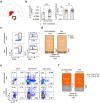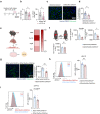CD4+ T cell-derived IL-22 enhances liver metastasis by promoting angiogenesis
- PMID: 37876835
- PMCID: PMC10591777
- DOI: 10.1080/2162402X.2023.2269634
CD4+ T cell-derived IL-22 enhances liver metastasis by promoting angiogenesis
Abstract
Metastasis is a cancer-related systemic disease and is responsible for the greatest mortality rate among cancer patients. Interestingly, the interaction between the immune system and cancer cells seems to play a key role in metastasis formation in the target organ. However, this complex network is only partially understood. We previously found that IL-22 produced by tissue resident iNKT17 cells promotes cancer cell extravasation, the early step of metastasis. Based on these data, we aimed here to decipher the role of IL-22 in the last step of metastasis formation. We found that IL-22 levels were increased in established metastatic sites in both human and mouse. We also found that Th22 cells were the key source of IL-22 in established metastasis sites, and that deletion of IL-22 in CD4+ T cells was protective in liver metastasis formation. Accordingly, the administration of a murine IL-22 neutralizing antibody in the establishment of metastasis formation significantly reduced the metastatic burden in a mouse model. Mechanistically, IL-22-producing Th22 cells promoted angiogenesis in established metastasis sites. In conclusion, our findings highlight that IL-22 is equally as important in contributing to metastasis formation at late metastatic stages, and thus, identify it as a novel therapeutic target in established metastasis.
Keywords: IL-22; Th22; liver metastasis.
© 2023 The Author(s). Published with license by Taylor & Francis Group, LLC.
Conflict of interest statement
No potential conflict of interest was reported by the author(s).
Figures







References
-
- Lan Q, Lai W, Zeng Y, Liu L, Li S, Jin S, Zhang Y, Luo X, Xu H, Lin X, et al. CCL26 participates in the PRL-3–induced promotion of colorectal cancer invasion by stimulating tumor-associated macrophage infiltration. Mol Cancer Ther. 2018;17(1):276–289. doi: 10.1158/1535-7163.MCT-17-0507. - DOI - PubMed
MeSH terms
Substances
LinkOut - more resources
Full Text Sources
Medical
Research Materials
